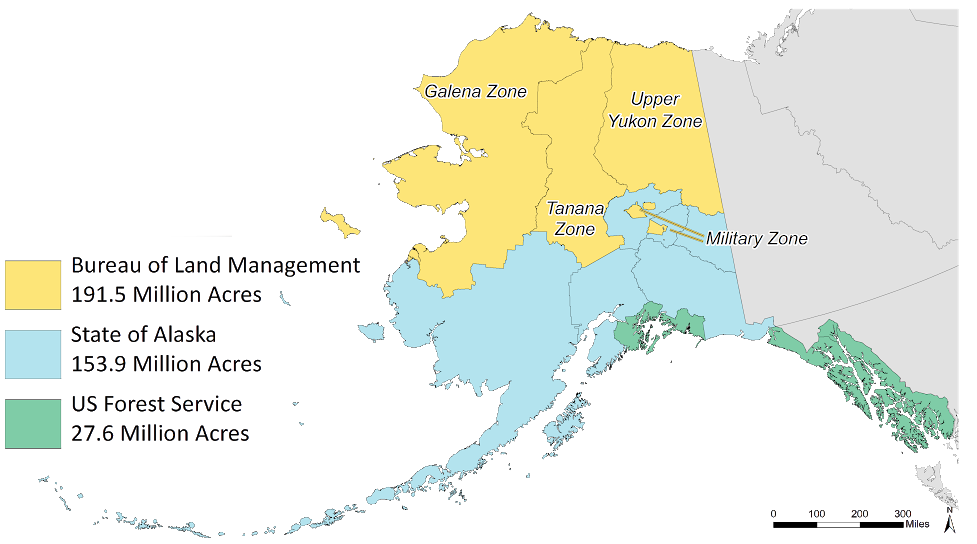Fire Management in Alaska
Numerous jurisdictional agencies are responsible for managing the lands in Alaska and ensuring they receive an appropriate level of wildfire protection.
The goal of both the BLM and the Alaska interagency fire management program is to protect the public, firefighters, and identified sites from wildland fire while providing an opportunity, through interagency cooperation and collaboration, for BLM to accomplish fire-related, land-use and resource management objectives in a cost-efficient manner, consistent with BLM and Department of the Interior policies.
The protection of human life is the single, overriding suppression priority.
Fire Protection Areas
The Alaska Master Agreement and Statewide Operating Plan provide additional interagency direction for effective and efficient use of resources among the partner agencies. The agreement allocates suppression responsibility to just three protecting agencies that act as service providers for the jurisdictional agencies.
Wildfire protection is provided by the Bureau of Land Management Alaska Fire Service (BLM AFS), State of Alaska Division of Forestry & Fire Protection, and the U.S. Forest Service for nearly all lands in Alaska. These three agencies provide protection services based on geographic boundaries that are independent of jurisdiction.

The three suppression agencies work with and for the jurisdictional agencies to implement preplanned responses to fire. The agencies have agreed to a statewide plan with four response levels, ranging from very aggressive initial attack to site-specific protection that allows fire to continue to play its vital role in the ecosystem (Critical, Full, Modified, Limited described in the Alaska Interagency Wildland Fire Management Plan). These management options drive initial response, but still allow for flexibility as fires develop and are assessed, so that subsequent decisions about strategy and resource allocation are made based on the current situation regardless of management option.
When the initial plans were developed in the 1980s, managers realized that agencies had not been effective at suppressing fires across Alaska and that much of the ecosystem was still intact and was dependent on naturally occurring fires. The current plan allows agencies to focus suppression efforts where they can be most effective at protecting lives, infrastructure and valuable cultural and natural resources.
AFS Fire Management Zones
BLM AFS Fire Management Zones provide direction for the development and execution of long- and short-range goals, policies and standardized procedures within AFS’s protection area in northern Alaska. They develop and maintain one-on-one relationships with the other Zones in the AFS as well as other federal, state and Native and Tribal land managers/owners to ensure land management objectives are understood and accomplished. Each Zone ensures that fire suppression strategies and tactics are responsive to the land managers/owners and their land management goals, objectives and protection standards. The Zones ensure that fire management readiness levels for their crews, equipment and facilities are commensurate with predicted and actual fire occurrence, behavior and general workload. The Zones coordinate with the other DOI offices as well as other federal, state and Native land managers and owners in developing fuels management programs, prescribed fire planning and implementation and hazardous fuels reduction projects. The Zones provide assistance in fire management planning to all of the land managers in their respective Zones and assist the BLM field offices in updating their Land Use Plans.
Each Zone is managed by a Fire Management Officer (FMO) who is a line officer at the AFS. The FMO provides fire management leadership and is responsible for the execution of all fire management, logistical, aviation and support activities within the geographical area of responsibility. The exception being the South Zone, which falls outside AFS protection area and is managed by a Fire Management Specialist.
Within their respective zones, fire management staff coordinate joint suppression operations with the State of Alaska and U.S. Forest Service suppression forces. Zone staff jointly develop the wildland fire management decision process with affected land managers for fires that exceed initial attack control capability. The Zones conduct operational reviews relating to fire suppression performance for responsiveness to client agency requirements and compliance with policies, objectives, standards, safety and overall effectiveness of operation.
The Zones provide incident business management oversight and direction for incident operations. They coordinate incident management team activities by delegating authority, ensuring adherence to state and federal business requirements and preparing, reviewing, and authorizing fiscal documents.
AFS Zone Acres
- Galena: 93,598,533
- Military:1,608,508
- Tanana: 44,314,282
- Upper Yukon: 51,973,750
